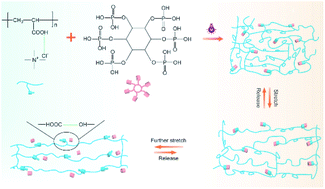Polymerizable deep eutectic solvent-based mechanically strong and ultra-stretchable conductive elastomers for detecting human motions†
Abstract
Conductive elastomers (CEs) with strong mechanical properties have been fabricated and used in flexible electronics. However, the development of CEs with both super-high mechanical strength and extreme stretchability remains challenging. This paper reports on the development of a series of mechanically strong and tough CEs based on photopolymerizable deep eutectic solvents (PDESs) with dense hydrogen bonding interactions. One of these CEs exhibits the highest reported mechanical performance for elastomers, with tensile strength, strain at break and toughness up to 31.21 MPa, 3645% and 615 MJ m−3, respectively. Notably, this CE tolerates puncture and can lift a 10.5 kg weight (9500 times its own weight) without any failure. In addition, the series of CEs also shows excellent transparency (>94% in the visible range), favorable conductivity (0.007–0.04 S m−1), tunable stretchability (strain from 22% to 6164%) and good self-healing capability (electrical healing efficiency of 99% within 0.26 s). In view of the comprehensive properties of the CEs, we demonstrate the practical suitability of CEs by including them in a strain sensor to detect human motion. Based on their extremely facile preparation process and practical functionalities, we believe that CEs will not only contribute new methods for the development of mechanically strong conductors, but also open up novel avenues for flexible electronics.



 Please wait while we load your content...
Please wait while we load your content...